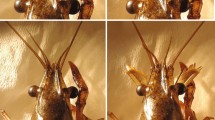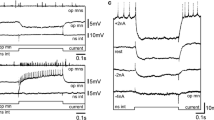Abstract
Three pairs of nonspiking giant interneurons (NGIs; G1, G2, and G3) of the crayfish brain responded with depolarizing and hyperpolarizing graded potentials to body tilt in roll to the ipsi- and contralateral sides in the dark. The higher and the larger the angle of body tilt, the larger was the amplitude of the geotactic responses. In ipsilaterally statocystectomized animals, all the NGIs responded with hyperpolarizing potentials only to the contralateral side-down tilt, whereas in contralaterally statocystectomized animals, they responded with depolarizing potentials only to the ipsilateral side-down tilt. In bilaterally statocystectomized animals, none of the NGIs responded to body tilt in the dark, but in the presence of an overhead light, they exhibited depolarizing and hyperpolarizing potentials in response to body tilt to the ipsi-and contralateral sides, respectively. All the NGIs responded with depolarizing and hyperpolarizing graded potentials to illumination of the contra- and ipsilateral eyes, respectively. The amplitude of these visual responses, however, varied in association with the amplitude of the geotactic response produced by body tilt. These results indicate that the NGIs integrate the sensory inputs from eyes and statocysts and that the interaction between sensory inputs from the left and right sensory organs with either the same modality or with different modalities enhance the directional sensitivity of NGIs as premotoneurons in the compensatory oculomotor system.
Similar content being viewed by others
References
Burnstock G (1976) Do some nerve cells release more than one transmitter? Neuroscience 1:239–248
Fay RR (1973) Multisensory interaction in control of eye-stalk rotation response in the crayfish (Procambarus clarkii). J Comp Physiol Psychol 84:527–533
Glantz RM, Nudelman HB, Waldrop B (1984) Linear integration of convergent visual inputs in an oculomotor reflex pathway. J Neurophysiol 52:1213–1225
Harreveld van A (1936) A physiological solution for freshwater crustaceans. Proc Soc Exp Biol Med 34:428–432
Higuchi T, Hisada M (1973) Visual and geotactic contributions to oculomotor responses in the crayfish, Procambarus clarki. J Fac Sci Hokkaido Univ (Zool) 18:495–506
Hisada M, Higuchi T (1973) Basic response pattern and classification of oculomotor nerve in the crayfish, Procambarus clarki. J Fac Sci Hokkaido Univ (Zool) 18:481–494
Kirk MD, Waldrop B, Glantz RM (1982) The crayfish sustaining fibers I. Morphological representation of visual receptive fields in the second optic neuropil. J Comp Physiol 146:175–179
Mellon DeF (1977) The anatomy and motor nerve distribution of the eye muscles in the crayfish. J Comp Physiol 121:349–366
Mellon DeF, Lorton ED (1977) Reflex actions of the functional divisions in the crayfish oculomotor system. J Comp Physiol 121:367–380
Nakagawa H, Hisada M (1992) Local spiking interneurons controlling the equilibrium response in the crayfish Procambarus clarkii. J Comp Physiol A 170:291–302
Nalbach H-O, Zeil J, Forzin L (1989) Multisensory control of eye-stalk orientation in space: crabs from different habitats rely on different senses. J Comp Physiol A 165:643–649
Neil DM (1982) Compensatory eye movements. In: Sandeman DC, Atwood HL (eds) The biology of Crustacea, Vol. 4. Academic Press, New York, pp 133–163
Neil DM (1985) Multisensory interactions in the crustacean equilibrium system. In: Barnes WJP, Gladden MH (eds) Feedback and motor control in invertebrates and vertebrates. Croom Helm, London Sydney Dover, pp 277–298
Okada Y, Yamaguchi T (1985) Eyestalk movements in the crayfish, Procambarus clarkii. Comp Biochem Physiol 81A: 157–164
Okada Y, Yamaguchi T (1987) Responses of nonspiking giant interneurons to magnetic field and visual stimulation in the cray-fish. Zool Sci 4:961
Okada Y, Yamaguchi T (1988a) Nonspiking giant interneurons in the crayfish brain: morphological and physiological characteristics of the neurons postsynaptic to visual interneurons. J Comp Physiol A 162:705–714
Okada Y, Yamaguchi T (1988b) Nonspiking giant interneurons (NGIs) in the crayfish brain and their responsiveness to multimodal sensory inputs. Zool Sci 5:1197
Okada Y, Yamaguchi T (1989) Response properties of nonspiking giant interneurons in the crayfish brain. Zool Sci 6:1074
Olivo RF, Jazak MM (1980) Proprioception provides a major input to the horizontal oculomotor system of crayfish. Vision Res 20:349–353
Schöne H, Neil DM, Scapini F, Dreissmann G (1983) Interaction of substrate, gravity and visual cues in the control of compensatory eye responses in the spiny lobster, Palinurus vulgaris. J Comp Physiol 150:23–30
Sigvardt KA, Mulloney B (1982) Properties of synapses made by IVN command-interneurones in the stomatogastric ganglion of the spiny lobster Panulirus interruptus. J Exp Biol 97:153–168
Stewart WW (1978) Functional connections between cells as revealed by dye-coupling with a highly fluorescent naphthalimide tracer. Cell 14:741–759
Wachtel H, Kandel ER (1967) A direct synaptic connection mediating both excitation and inhibition. Science 158:1206–1208
Wiersma CAG, Oberjat T (1968) The selective responsiveness of various crayfish oculomotor fibers to sensory stimuli. Comp Biochem Physiol 26:1–16
Wiersma CAG, Yamaguchi T (1966) The neuronal components of the optic nerve of the crayfish as studied by single unit analysis. J Comp Neurol 128:333–358
Wiersma CAG, Yamaguchi T (1967) Integration of visual stimuli by the crayfish central nervous system. J Exp Biol 47:409–431
Yamaguchi T, Okada Y (1990) Giant brain neurons of the crayfish: their functional roles in the compensatory oculomotor system. In: Wiese K et al. (eds) Frontiers in crustacean neurobiology. Birkhäuser, Basel Boston Berlin, pp 193–199
Yamaguchi T, Okada Y, Nakatani K, Ohta N (1984) Functional morphology of visual interneurons in the crayfish central nervous system. In: Aoki K et al. (eds) Animal behavior: neurophysiological and ethological approaches. Jpn Sci Soc Press/ Springer, Berlin Heidelberg New York Tokyo, pp 109–122
Yoshino M, Kondoh Y, Hisada M (1983) Projection of statocyst sensory neurons associated with crescent hairs in the crayfish Procambarus clarkii Girard. Cell Tissue Res 230:37–48
Author information
Authors and Affiliations
Rights and permissions
About this article
Cite this article
Okada, Y., Furudate, H. & Yamaguchi, T. Multimodal responses of the nonspiking giant interneurons in the brain of the crayfish Procambarus clarkii . J Comp Physiol A 174, 411–419 (1994). https://doi.org/10.1007/BF00191707
Accepted:
Issue Date:
DOI: https://doi.org/10.1007/BF00191707




